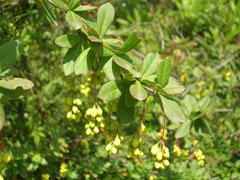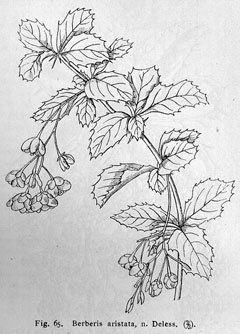 |
|
http://commons.wikimedia.org/wiki/User:Shyamal |
 |
| Drawing out of Handbuch der Laubholzkunde by Dr. Leopold Dippel from 1889 |
Translate this page:
Summary
Barberries are dense, neat-growing, medium to large deciduous and evergreen shrubs. Native species exist in many areas, including Europe and North America. Deciduous forms often have spectacular autumn leaf colour and berries. Barberries will grow in sun or light shade but will fruit better in full sun and not flower in deep shade. Ornamental leaves, yellow flowers, and attractive berries make them popular garden plants. The dense and spiny growth habit makes them excellent hedges and barriers and shelter for wildlife. Many species have pleasant edible fruit that is eaten raw or cooked.
Indian Barberry (B. aristata) is a large evergreen shrub growing to 3.5m (12ft). Its fruit is sweet and well-flavoured, with a blend of acid and a slight bitterness caused by the seeds. The fruit is eaten raw, cooked, or dried and used like raisins. The flower buds are added to sauces.
Physical Characteristics

 Berberis aristata is an evergreen Shrub growing to 3.5 m (11ft 6in) at a medium rate.
Berberis aristata is an evergreen Shrub growing to 3.5 m (11ft 6in) at a medium rate.
See above for USDA hardiness. It is hardy to UK zone 6 and is not frost tender. It is in leaf all year, in flower in May. The species is hermaphrodite (has both male and female organs) and is pollinated by Insects. The plant is self-fertile.
It is noted for attracting wildlife.
Suitable for: light (sandy), medium (loamy) and heavy (clay) soils and can grow in heavy clay and nutritionally poor soils. Suitable pH: mildly acid, neutral and basic (mildly alkaline) soils. It can grow in semi-shade (light woodland) or no shade. It prefers dry or moist soil.
UK Hardiness Map
US Hardiness Map
Synonyms
B. chitria. B. coriaria.
Plant Habitats
Woodland Garden Dappled Shade; Shady Edge;
Edible Uses
Edible Parts: Flowers Fruit
Edible Uses:
Fruit - raw or cooked[145]. A well-flavoured fruit, it has a sweet taste with a blend of acid, though there is a slight bitterness caused by the seeds[194, K]. The fruit is much liked by children[194, K]. It is dried and used like raisins in India[2, 3, 177, 183]. The fruit contains about 2.3% protein, 12% sugars, 2% ash, 0.6% tannin, 0.4% pectin[194]. There is 4.6mg vitamin C per 100ml of juice[194].The fruit is about 7mm x 4mm[194] - it can be up to 10mm long[200]. Plants in the wild yield about 650g of fruit in 4 pickings[194]. Flower buds - added to sauces[177, 183].
References More on Edible Uses
| Composition
|
| Figures in grams (g) or miligrams (mg) per 100g of food.
|
|
|
Fruit (Fresh weight)
|
|
- 0 Calories per 100g
- Water : 0%
- Protein: 2.3g; Fat: 0g; Carbohydrate: 12g; Fibre: 0g; Ash: 2g;
- Minerals - Calcium: 0mg; Phosphorus: 0mg; Iron: 0mg; Magnesium: 0mg; Sodium: 0mg; Potassium: 0mg; Zinc: 0mg;
- Vitamins - A: 0mg; Thiamine (B1): 0mg; Riboflavin (B2): 0mg; Niacin: 0mg; B6: 0mg; C: 0mg;
- Reference: [ ]
- Notes:
|
|
Medicinal Uses
Plants For A Future can not take any responsibility for any adverse effects from the use of plants. Always seek advice from a professional before using a plant medicinally.
Alterative Antibacterial Antiperiodic Bitter Cancer Deobstruent Diaphoretic Dysentery
Laxative Malaria Ophthalmic Tonic Vitamin C
The dried stem, root bark and wood are alterative, antiperiodic, deobstruent, diaphoretic, laxative, ophthalmic and tonic (bitter)[46, 61, 158, 194, 240]. An infusion is used in the treatment of malaria, eye complaints, skin diseases, menorrhagia, diarrhoea and jaundice[240, 243]. Berberine, universally present in rhizomes of Berberis species, has marked antibacterial effects. Since it is not appreciably absorbed by the body, it is used orally in the treatment of various enteric infections, especially bacterial dysentery[218]. It should not be used with Glycyrrhiza species (Liquorice) because this nullifies the effects of the berberine[218]. Berberine has also shown antitumour activity[218].
References More on Medicinal Uses
The Bookshop: Edible Plant Books
Our Latest books on Perennial Plants For Food Forests and Permaculture Gardens in paperback or digital formats.

Edible Tropical Plants
Food Forest Plants for Hotter Conditions: 250+ Plants For Tropical Food Forests & Permaculture Gardens.
More

Edible Temperate Plants
Plants for Your Food Forest: 500 Plants for Temperate Food Forests & Permaculture Gardens.
More

More Books
PFAF have eight books available in paperback and digital formats. Browse the shop for more information.
Shop Now
Other Uses
Dye Fuel Tannin
A yellow dye is obtained from the root and the stem[46, 61, 272]. An important source of dyestuff and tannin, it is perhaps one of the best tannin dyes available in India[194]. The wood is used as a fuel[146]. The spiny branches are used for making fencing around fields[272]. 1. Nectary - Flowers rich in nectar and pollen:
Yes – Barberry flowers are small but rich in nectar and pollen, attracting bees and other pollinators.
2. Wildlife - Food (Fruit, Seeds, Leaf litter, Shelter, Nesting, Roosting):
Yes – Barberry produces edible berries that are a food source for birds and other wildlife. The dense, thorny branches provide good shelter and protection for nesting and roosting birds.
3. Invertebrate Shelter (Overwintering sites, Leaf litter, Groundcover):
Yes – The dense structure of Barberry shrubs and their leaf litter can offer overwintering sites and shelter for invertebrates.
4. Pest Confuser (Smell):
No – Barberry is not known for emitting a smell that confuses pests.
Special Uses
Food Forest
References More on Other Uses
Cultivation details
Prefers a warm moist loamy soil and light shade but it is by no means fastidious, succeeding in thin, dry and shallow soils[11, 200]. Grows well in heavy clay soils. Plants are very hardy, they survived the severe winters of 1986-1987 without problems in most areas of Britain[K]. Plants can be pruned back quite severely and resprout well from the base[200]. The fruits are sometimes sold in local markets in India[194]. Hybridizes freely with other members of this genus[1]. Most plants cultivated under this name are B. chitria., B. coriaria., B. glaucocarpa. and, more commonly, B. floribunda[67, 200]. The berries are typically harvested in late summer to early autumn when they are ripe.
Barberry generally flowers in spring, depending on the species and local climate. Barberry is a moderately fast-growing plant, often reaching maturity in 3 to 5 years, depending on the species and growing conditions.
References Carbon Farming Information and Carbon Sequestration Information
Temperature Converter
Type a value in the Celsius field to convert the value to Fahrenheit:
Fahrenheit:
The PFAF Bookshop
Plants For A Future have a number of books available in paperback and digital form. Book titles include Edible Plants, Edible Perennials, Edible Trees,Edible Shrubs, Woodland Gardening, and Temperate Food Forest Plants. Our new book is Food Forest Plants For Hotter Conditions (Tropical and Sub-Tropical).
Shop Now
Plant Propagation
Seed - best sown as soon as it is ripe in a cold frame, it should germinate in late winter or early spring[78]. Seed from over-ripe fruit will take longer to germinate[78]. Stored seed may require cold stratification and should be sown in a cold frame as early in the year as possible[80]. When they are large enough to handle, prick the seedlings out into individual pots and grow them on in the greenhouse or cold frame for at least their first winter. Once they are at least 20cm tall, plant them out into their permanent positions in late spring or early summer, after the last expected frosts. The seedlings are subject to damping off, so be careful not to overwater them and keep them well ventilated[113]. Cuttings of half-ripe wood, July/August in a frame. Very difficult, if not impossible. Cuttings of mature wood of the current season's growth, preferably with a heel, October/November in a frame[78]. Very difficult, if not impossible.
Other Names
If available other names are mentioned here
Akhray, Barberry (Zirishk), Chitra, Dar-hald, Darhaldi, Daruhald, Daruhalli, Darukaridra, Gruch, Kashmal, Kimor, Nepal Berberis, Rasaut, Simlu,
Native Range
TROPICAL ASIA: Bhutan, India, Uttar Pradesh, Nepal,
Weed Potential
Right plant wrong place. We are currently updating this section.
Please note that a plant may be invasive in one area but may not in your area so it's worth checking.
Conservation Status
IUCN Red List of Threatened Plants Status :

Growth: S = slow M = medium F = fast. Soil: L = light (sandy) M = medium H = heavy (clay). pH: A = acid N = neutral B = basic (alkaline). Shade: F = full shade S = semi-shade N = no shade. Moisture: D = dry M = Moist We = wet Wa = water.
Now available:
Food Forest Plants for Mediterranean Conditions
350+ Perennial Plants For Mediterranean and Drier Food Forests and Permaculture Gardens.
[Paperback and eBook]
This is the third in Plants For A Future's series of plant guides for food forests tailored to
specific climate zones. Following volumes on temperate and tropical ecosystems, this book focuses
on species suited to Mediterranean conditions—regions with hot, dry summers and cool, wet winters,
often facing the added challenge of climate change.
Read More
Expert comment
Author
DC.
Botanical References
1151200
Links / References
For a list of references used on this page please go here
Readers comment
© 2010, Plants For A Future. Plants For A Future is a charitable company limited by guarantee, registered in England and Wales. Charity No. 1057719, Company No. 3204567.